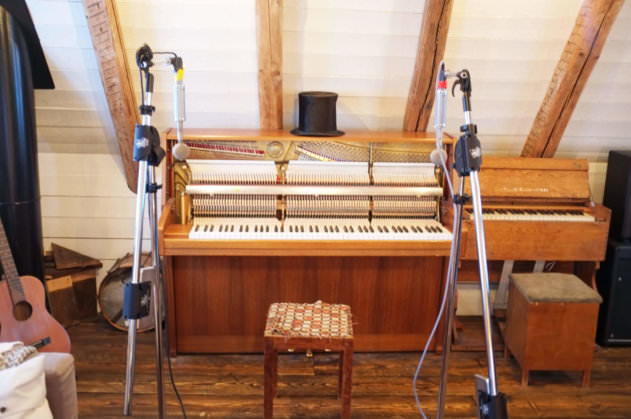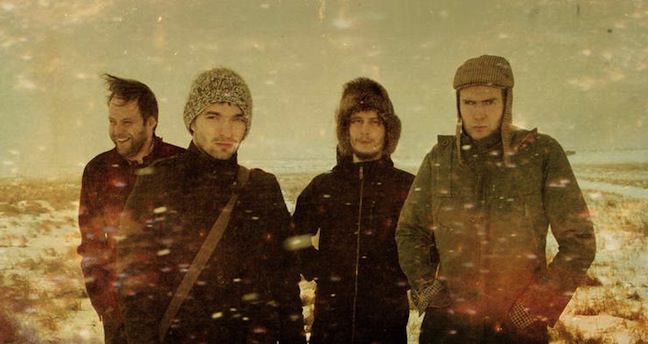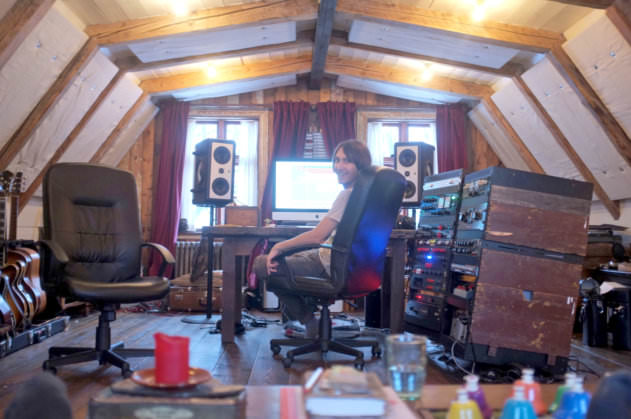Somers’ custom-designed studio occupies the entire second floor of his home and, although it has Pro Tools if his clients want to use it, he prefers to run Logic for all of his own work.
A single space that combines the recording area and control room, it houses a large collection of outboard gear, microphones, guitar amps, bass amps and instruments – ranging from a piano and glockenspiel to a dulcitone, harmonium, celeste and marxophone (a type of fretless zither). Next year, he plans to move into a larger studio – with a separate control room, live area and isolation booths – in downtown Reykjavic.
“I can record pretty much anything here,” Somers says about his current facility. “I’ve even done drums, although the studio isn’t ideal for that as it’s fairly small. Usually, when I record a band, I book about a week at Sundlaugin to do the drums, strings, orchestrations, brass and choir, and then I do everything else – including the mix – at my studio.”
shaping
Alex’s initial work on the Valtari project involved a lot of experimenting, shaping and moulding of the material with the Sigur Rós members – including the ‘Logn’ [‘Calm’] and ‘Kvistur’ [‘Branch’] that, omitted from the 54-minute-long album, have instead been made available to record buyers as pre-order bonus tracks.
“I would have the guys – sometimes individually, sometimes together – come up to my studio and do overdubs,” Somers recalls. “That’s what made this project so much fun for me. I have nice memories of calling them up and then having some cake and wine while doing the overdubs.
“For instance, Orri recorded some cymbals, Kjartan played a lot of his piano parts and Jónsi did three of his five lead vocals here; on ‘Ég anda’ [‘I Breathe’], ‘Ekki múkk’ [‘Not a Sound’] and ‘Rembihnútur’. He had already sung ‘Varúð’ and ‘Dauðalogn’ [‘Dead Calm’] at Sundlaugin.
“We just re-thought and gave shape to the songs that were super-vague. I don’t own a single synth in my studio but I really like to use samplers, and we did that a lot on Valtari. If you have a sound in your head or you want to experiment, I find it really creative to sample pianos or bells or your voice and then manipulate that to produce your own sound rather than just plug in a synth and hit ‘go’.
“So, when I was involved we didn’t record any synths, but I definitely assembled the songs in a way that’s similar to the approach taken by electronic musicians – I really relate to how they build the music although I don’t use synthesised instruments.
we didn’t record any synths, but I definitely assembled the songs in a way that’s similar to the approach taken by electronic musicians
“For instance, on ‘Ég anda’ everything was very ambient, with one chord that kept going. However, the bass guitar had already been done, and I remember latching onto that and going, ‘Okay, here’s a chord progression we can build off.’ Also, Jónsi created this kind of beat from a heartbeat sound, so the drum sound that comes in about halfway through the song is, in fact, a heartbeat, not a kick drum.
“That actually made it the hardest song on the album for me to mix. We never wanted it to climax with that heartbeat thump, but at the same time it had to build enough to be exciting and the tiniest bit threatening. Also, the heartbeat sound was so bassy and thumpy, I just kept re-treating it to get the low end right and not over-compress it. So, that was a bit tricky.
sampling
“We did a lot of sampling. While I was mixing, Jónsi, Kjarri [Kjartan] and Orri sat at the back of the studio with this little sampler called an OP-1 and recorded the sound of the speakers playing into the room. Then they’d slow it down or speed it up and generally mess with it, and once an hour they’d walk over to me and say, ‘Hey, can we record a little overdub?’ That was because they’d just written a part based on a sample of the song. So, that’s where a lot of the unusual textures in ‘Ég anda’ came from – the song re-sampled.
“We also used the marxophone – which is a new instrument we got in the studio a few months ago – to create the sort of clangy sounds that appear about a minute into the song. That’s a slowed-down marxophone, recorded with an AEA R84 or a Neumann U47, and then Goggi added some glockenspiel while Orri overdubbed cymbals.
I always use a ribbon mic for any kind of bells – they just take the top end much better, especially when there are crazy overtones. In this case I used an R84 together with an AEA RPQ two-channel ribbon mic pre-amp, some Chandler Curve Bender EQ and a few dB of compression from the Thermionic Culture Phoenix, helping it to sound more even.
“My mix buss chain was a TC Fat Bustard mixer, the Phoenix compressor, the Curve Bender EQ and the Kush Audio Clariphonic parallel equalizer that I got especially for this record and which sounds amazing, like no other EQ I’ve ever used.
“Kjartan and Orri played a lot of piano on this record, and for that we used a pair of Neumann CMV-563s going into a Thermionic Culture Rooster, Phoenix compressor and Curve Bender EQ. The only bass I recorded was a small overdub by Kjartan on ‘Rembihnútur’.

Recording piano with a pair of Neumann CMV-563s, which were then run into a Thermionic Culture Rooster, Phoenix compressor and Curve Bender EQ
vocals
“For the vocals that Jónsi recorded at my studio I used a tube U47, which is so flattering on his voice. It has a beautiful mid-range and, whereas a lot of modern condenser mics are overly bright, old Neumanns just sound so good.
“He’s a really good singer, capturing his voice is relatively easy and the Sta-Level compressor makes it sound pretty amazing. Then again, another cool pre-amp that I used on all of Jónsi’s vocals was a hand-built unit by Preservation Sound, where one guy recreates these old 1950s RCAs and other vintage designs. It literally has just one knob and it sounds amazing.
“Jónsi sang the songs all the way through, doing just one take, or a second one that we could comp from if there was a phrase we didn’t like. He also did a lot of backing vocals, and those were recorded really fast – once he came up with a backing vocal line, he’d do four performances straight away, and I’d then pan them left-right-left-right to get a really wide, choir-like effect.”
To record Jónsi’s guitar, Somers miked a Marshall stack with a Neumann U47 that he placed about five feet away to also capture some room sound. “I never use two mics on guitar amps,” he says. “I’ve found that can cause phasing issues when it comes to the mix. And I’m also not a fan of the sound that’s produced by placing mics close to instruments.
distortion
‘Varúð’ was the only Valtari track that Sigur Rós recorded together as a band at Sundlaugin, yet even this was reworked by the band once Somers was on board as co-producer.
“I just distorted everything to hell with a Thermionic Culture Vulture,” recalls Somers, who spent two to three days mixing each song.
“There were drums playing throughout that track, so I muted them until the final, crazy 30 seconds, and during the mix I then ran everything through the Culture Vulture with various levels of distortion.
“In fact, the drum kit actually ended up being run through it twice, and I also distorted the bass, the string section and Jónsi’s trademark bow guitar [produced by him running a cello bow across the strings]. Beforehand, the song had a rock ending, but I wanted it to be less rock-sounding. I didn’t want it to be like a rock band kicking ass; I wanted it to be more like an insane moment of really melodic noise, and I think we got there in the end.
“That having been said, I also think the second-to-last song – the title track – is one of the most interesting things the band has ever done. It’s kind of weird and warpy, and if you surrender to it, it’s a really cool piece of music; dark and eerie, but still beautiful in its own way.
“Interestingly, that song was the one that remained closest to how it had been before I got involved. Some numbers changed radically, but ‘Valtari’ didn’t change much at all. I just asked Jónsi if he would do some bow guitar, so he played that here in the studio, and I also treated Kjartan’s piano quite a bit, using a chain of software effects – including a plug-in from a company called SoundHack – to get a deranged sort of warping sound that I was quite happy with.”
Indeed, although the final three, instrumental numbers on Valtari – ‘Varðeldur’ [‘Campfire’], the aforementioned title track and ‘Fjögur píanó’ [‘Four Pianos’] – meld seamlessly to form a subtle, ambiently introspective closing suite, Alex states that it was his intention for the overall effect to be of the album comprising individual songs.
“If you listen, everything on that record is a song, with a melody and a chord structure,” he says. “Some of them are really slow and the chord changes unfold very gradually. But, as much as I like ambient music, I didn’t want the guys to just focus on that. Part of what makes them such a good band is that they write really good songs with really good chord progressions. So, I want to combine that with the ambient music, and I think the record probably would have been more ambient if I wasn’t involved.”


10.49 PM
Great interview! Wonderful to get an insight into the creative process of an album like this one.